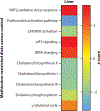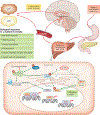The Origins, Evolution, and Future of Dietary Methionine Restriction
- PMID: 35588443
- PMCID: PMC9936953
- DOI: 10.1146/annurev-nutr-062320-111849
The Origins, Evolution, and Future of Dietary Methionine Restriction
Abstract
The original description of dietary methionine restriction (MR) used semipurified diets to limit methionine intake to 20% of normal levels, and this reduction in dietary methionine increased longevity by ∼30% in rats. The MR diet also produces paradoxical increases in energy intake and expenditure and limits fat deposition while reducing tissue and circulating lipids and enhancing overall insulin sensitivity. In the years following the original 1993 report, a comprehensive effort has been made to understand the nutrient sensing and signaling systems linking reduced dietary methionine to the behavioral, physiological, biochemical, and transcriptional components of the response. Recent work has shown that transcriptional activation of hepatic fibroblast growth factor 21 (FGF21) is a key event linking the MR diet to many but not all components of its metabolic phenotype. These findings raise the interesting possibility of developing therapeutic, MR-based diets that produce the beneficial effects of FGF21 by nutritionally modulating its transcription and release.
Keywords: FGF21; essential amino acids; insulin sensitivity; lipid metabolism; nutrient sensing; obesity.
Figures




Similar articles
-
Nutritional Regulation of Hepatic FGF21 by Dietary Restriction of Methionine.Front Endocrinol (Lausanne). 2021 Nov 30;12:773975. doi: 10.3389/fendo.2021.773975. eCollection 2021. Front Endocrinol (Lausanne). 2021. PMID: 34917032 Free PMC article. Review.
-
Sensing and signaling mechanisms linking dietary methionine restriction to the behavioral and physiological components of the response.Front Neuroendocrinol. 2018 Oct;51:36-45. doi: 10.1016/j.yfrne.2017.12.002. Epub 2017 Dec 21. Front Neuroendocrinol. 2018. PMID: 29274999 Free PMC article. Review.
-
The Role of Reduced Methionine in Mediating the Metabolic Responses to Protein Restriction Using Different Sources of Protein.Nutrients. 2021 Jul 29;13(8):2609. doi: 10.3390/nu13082609. Nutrients. 2021. PMID: 34444768 Free PMC article.
-
The role of suppression of hepatic SCD1 expression in the metabolic effects of dietary methionine restriction.Appl Physiol Nutr Metab. 2018 Feb;43(2):123-130. doi: 10.1139/apnm-2017-0404. Epub 2017 Oct 5. Appl Physiol Nutr Metab. 2018. PMID: 28982014 Free PMC article.
-
FGF21 Mediates the Thermogenic and Insulin-Sensitizing Effects of Dietary Methionine Restriction but Not Its Effects on Hepatic Lipid Metabolism.Diabetes. 2017 Apr;66(4):858-867. doi: 10.2337/db16-1212. Epub 2017 Jan 17. Diabetes. 2017. PMID: 28096260 Free PMC article.
Cited by
-
Effects of Dietary Methionine Restriction on Cognition in Mice.Nutrients. 2023 Nov 29;15(23):4950. doi: 10.3390/nu15234950. Nutrients. 2023. PMID: 38068808 Free PMC article. Review.
-
Adverse cardiac events of hypercholesterolemia are enhanced by sitagliptin in sprague dawley rats.Nutr Metab (Lond). 2024 Jul 30;21(1):54. doi: 10.1186/s12986-024-00817-9. Nutr Metab (Lond). 2024. PMID: 39080769 Free PMC article.
-
FGF21 as a mediator of adaptive changes in food intake and macronutrient preference in response to protein restriction.Neuropharmacology. 2024 Sep 1;255:110010. doi: 10.1016/j.neuropharm.2024.110010. Epub 2024 May 24. Neuropharmacology. 2024. PMID: 38797244 Review.
-
Sulfur Amino Acid Restriction Mitigates High-Fat Diet-Induced Molecular Alterations in Cardiac Remodeling Primarily via FGF21-Independent Mechanisms.Nutrients. 2024 Dec 17;16(24):4347. doi: 10.3390/nu16244347. Nutrients. 2024. PMID: 39770968 Free PMC article.
-
Dietary sulfur amino acid restriction in humans with overweight and obesity: a translational randomized controlled trial.J Transl Med. 2024 Jan 9;22(1):40. doi: 10.1186/s12967-023-04833-w. J Transl Med. 2024. PMID: 38195568 Free PMC article. Clinical Trial.
References
-
- Anthony TG, Gietzen DW. 2013. Detection of amino acid deprivation in the central nervous system. Curr. Opin. Clin. Nutr. Metab. Care 16:96–101 - PubMed
-
- Anthony TG, McDaniel BJ, Byerley RL, McGrath BC, Cavener DDR, et al. 2004. Preservation of liver protein synthesis during dietary leucine deprivation occurs at the expense of skeletal muscle mass in mice deleted for eIF2 kinase GCN2. J. Biol. Chem 279:36553–61 - PubMed
Publication types
MeSH terms
Substances
Grants and funding
LinkOut - more resources
Full Text Sources

